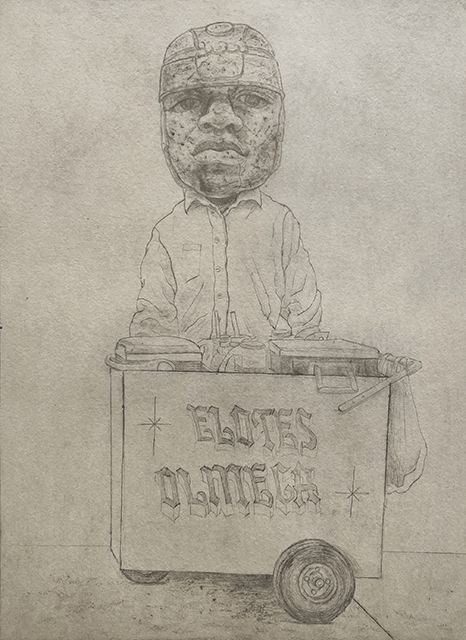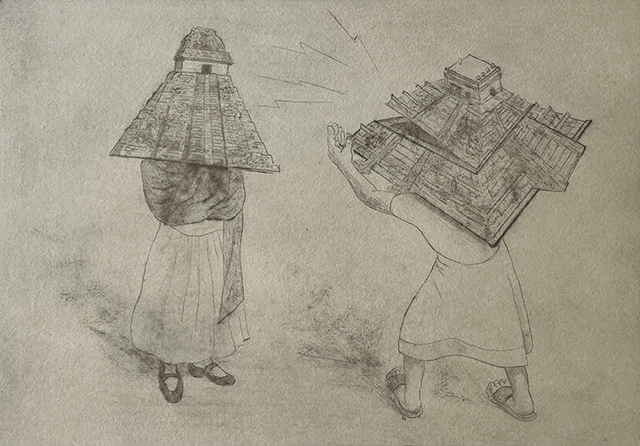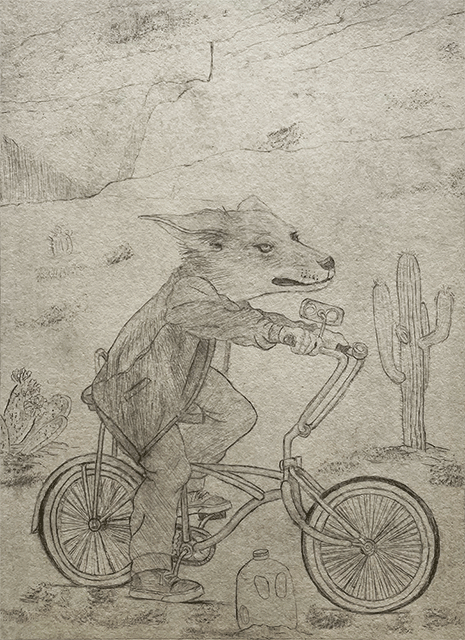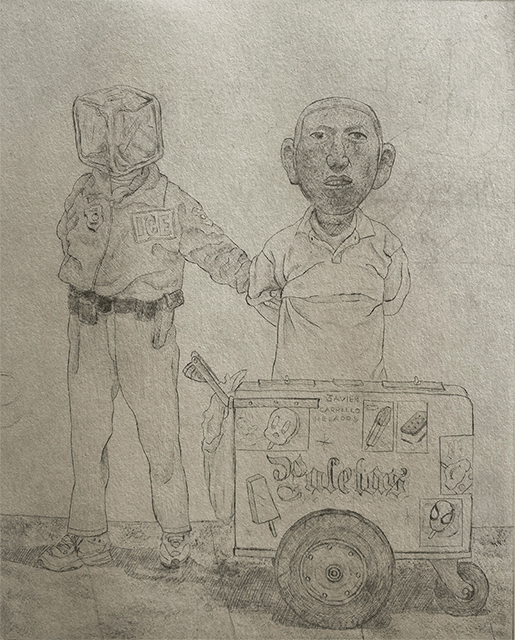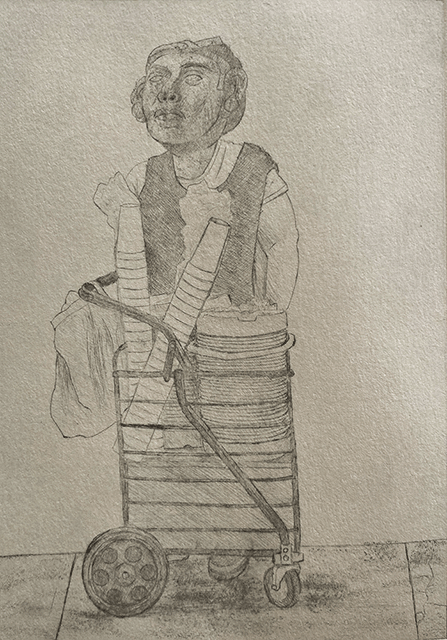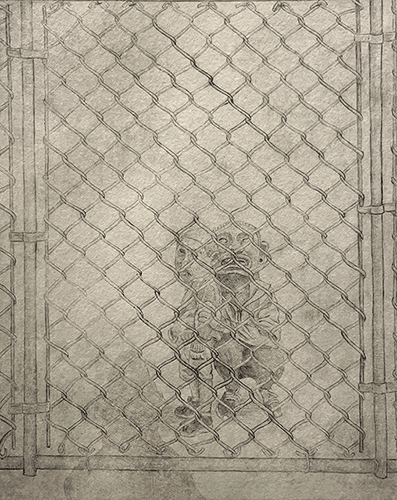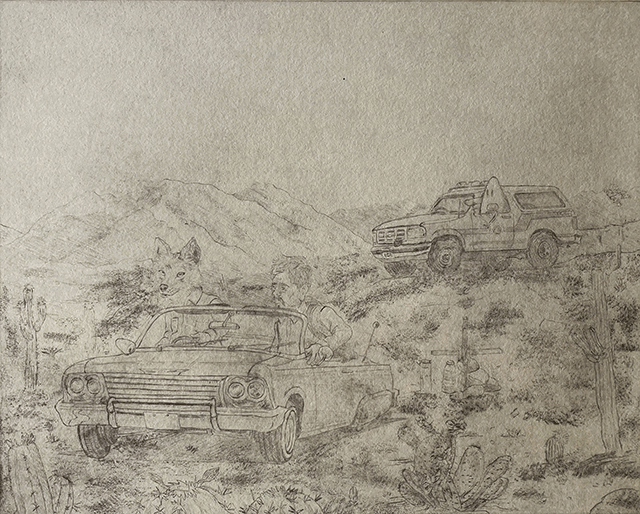
paper: 15 x 11 in. image 8 x 6 in, edition of 23 - $200
The perseverance of indigenous Olmec, Aztec, and Mayan cultural symbols, despite centuries of Spanish colonization, continues to serve as an emblem of resilience and pride for Latinx people facing modern-day struggles. Through acts of force, the Spanish ovelaid their religion and practices on top of existing native cultures, resulting in palimpsests and hybrid forms of culture over time. As contemporary Chicano artists explore the complex layers of their cultural identity, they often turn to reclaimed indigenous symbols and imagery of transformation to honor the adaptation of their ancestors who sacrificed for future generations. In Los Angeles, this blend of traditions is expressed through the work of artists such as Gilbert “Magu” Lujan who, for example, made a sequential drawing that morphed a crouching man into an Aztec pyramid that unfolded legs and became an “architectural” dog. The new etchings of Javier Carrillo build upon the magical realism of these “transformers,” bestowing historical resonance upon an LA street vendor by giving him a giant Olmec head, or following a “coyote-man” across the border as he rides a Sting-Ray bike. Carrillo describes the making of his new etchings:
“Early December of 2021, I began working on a dry-point etching depicting a Los Angeles street vendor. Growing up in LA, I would get excited during the late fall and winter for “The Elote man”. Sometimes I begged my parents for money so that I, my brother and sisters could enjoy a delicious hot “elote” (corn on a stick). This allowed us to stay a bit warm during cold days. As a kid, I never stopped to think about how hard a street vendor’s lifestyle can be. Just the thought of them walking around the big city of Los Angeles on a cold day, looking for customers, not to mention the energy it takes making the elote to the customers’ liking. I’m sure it can be exhausting.
The print of “Elotes, Olmeca'' is special to me because it’s the symbol of hard working Latinos that come to the US for a better life, and to escape violence and economic problems. The print also contains a Mexican Olmeca head that symbolizes the Mexican people. The viewer of this print is having a direct encounter with the street vendor, as if we are about to order an elote. The street vendors’ cart is important because this is how they carry their produce around, but it also includes decorations and sign paintings. As a Mexican artist I’m very curious about these types of cultural details that I see around my community.
The ink I chose for these prints is a graphite etching ink, which makes it look very similar to a pencil drawing, and produces a shine when the sun hits it directly. This choice was also significant because the Olmeca Head is sculpted from large basalt boulders in Mexico, a stone that has a similar shine.
These prints convey my respect for the hard working Latinx people and the cultural traditions of my barrio.”
All of the artwork in this email exhibition is available for purchase and is also viewable in the gallery as part of our ongoing salon, Brick and Mortar.
For inquiries, please call 310-828-6410 or email at info@craigkrullgallery.com.
“Early December of 2021, I began working on a dry-point etching depicting a Los Angeles street vendor. Growing up in LA, I would get excited during the late fall and winter for “The Elote man”. Sometimes I begged my parents for money so that I, my brother and sisters could enjoy a delicious hot “elote” (corn on a stick). This allowed us to stay a bit warm during cold days. As a kid, I never stopped to think about how hard a street vendor’s lifestyle can be. Just the thought of them walking around the big city of Los Angeles on a cold day, looking for customers, not to mention the energy it takes making the elote to the customers’ liking. I’m sure it can be exhausting.
The print of “Elotes, Olmeca'' is special to me because it’s the symbol of hard working Latinos that come to the US for a better life, and to escape violence and economic problems. The print also contains a Mexican Olmeca head that symbolizes the Mexican people. The viewer of this print is having a direct encounter with the street vendor, as if we are about to order an elote. The street vendors’ cart is important because this is how they carry their produce around, but it also includes decorations and sign paintings. As a Mexican artist I’m very curious about these types of cultural details that I see around my community.
The ink I chose for these prints is a graphite etching ink, which makes it look very similar to a pencil drawing, and produces a shine when the sun hits it directly. This choice was also significant because the Olmeca Head is sculpted from large basalt boulders in Mexico, a stone that has a similar shine.
These prints convey my respect for the hard working Latinx people and the cultural traditions of my barrio.”
For inquiries, please call 310-828-6410 or email at info@craigkrullgallery.com.
paper: 15 x 11 in. image 6.875 x 4.75 in, edition of 23 - $200
paper: 15 x 11 in. image: 7.875 x 6.25 in, edition of 23 - $200
Javier Carrillo, Prisioneros de su propia Tierra, 2021, graphite ink on BFK rives, paper: 15 x 11 in. image 6.875 x 4.75 in, edition of 23 - $200
Javier Carrillo, Corre, la Migra, 2021, graphite ink on BFK rives,
paper: 11 x 15 in. image 6.875 x 4.75 in, edition of 23 - $200
Javier Carrillo, Rasado Cart, Low Rider, 2021, graphite ink on BFK rives,
paper: 11 x 15 in. image 6.875 x 4.75 in, edition of 23 - $200
